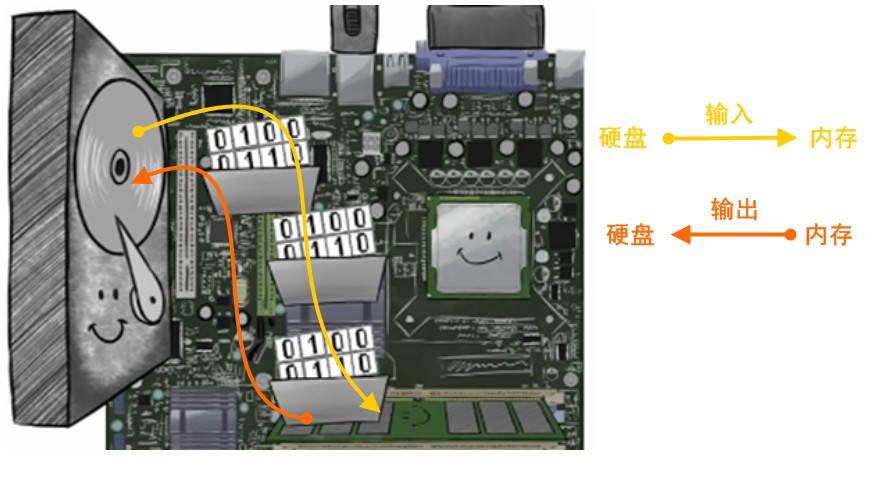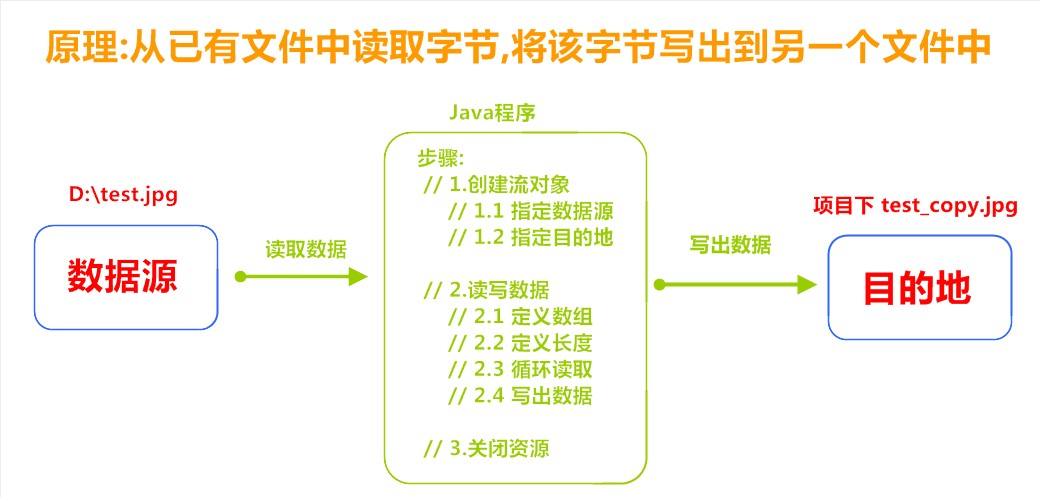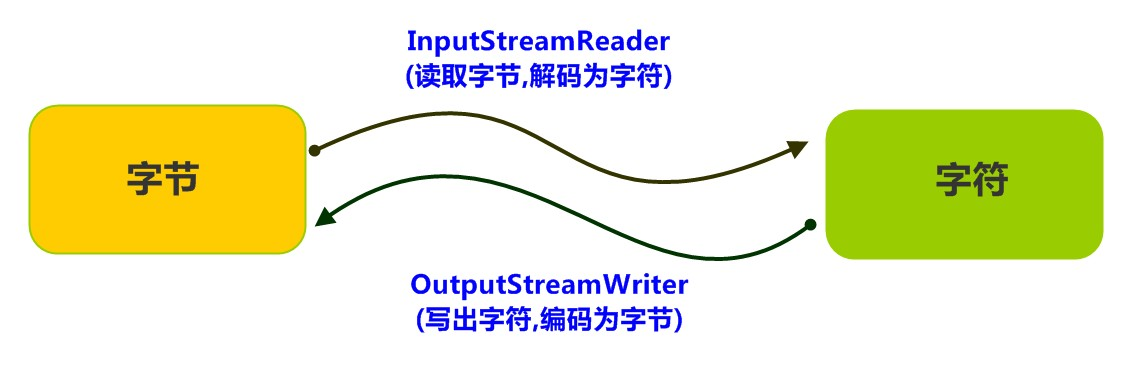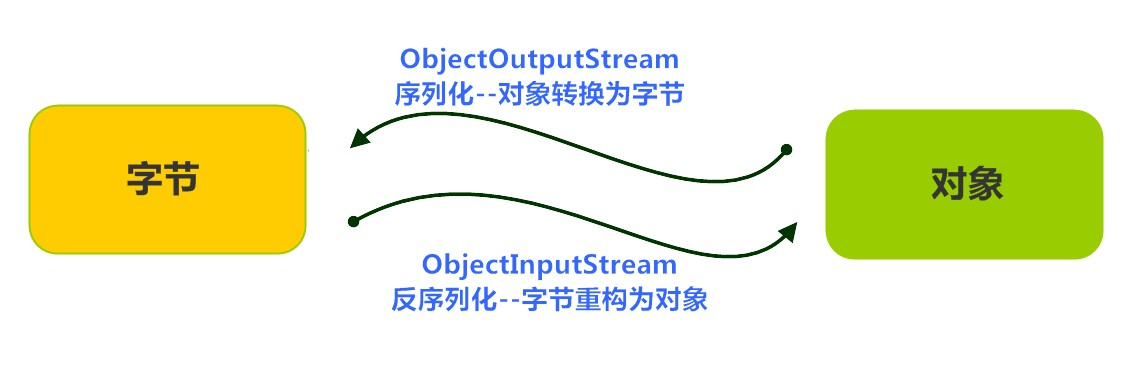IO流 IO概述 IO的概述
I : Input 输入 从其他存储设备读数据到内存中就是输入
O : Output 输出 从内存中写数据到其他存储设备
IO的分类 根据数据的流向分为:输入流 和输出流 。
输入流 :把数据从其他设备上读取到内存中的流。
字节输入流:以字节为基本单位,读数据
字符输入流:以字符为基本单位,读数据
输出流 :把数据从内存 中写出到其他设备上的流。
字节输出流:以字节为基本单位,写出数据
字符输出流:以字符为基本单位,写出数据
根据数据的类型分为:字节流 和字符流 。
字节流 :以字节为单位,读写数据的流。
字节输入流:以字节为基本单位,读数据
字节输出流:以字节为基本单位,写出数据
字符流 :以字符为单位,读写数据的流。
字符输入流:以字符为基本单位,读数据
字符输出流:以字符为基本单位,写出数据
IO的顶层父类
字节输入流:顶层父类 InputStream 抽象类
字节输出流:顶层父类 OutputStream 抽象类
字符输入流:顶层父类 Reader 抽象类
字符输出流:顶层父类 Writer 抽象类
注意事项
utf8编码一个中文占3个字节,gbk编码一个中文占2个字节
如果存储和解析的编码不一致就会乱码
idea默认编码是utf8
字节流 字节输出流【OutputStream】 OutputStream类的概述 java.io.OutputStream 抽象类是表示字节输出流的所有类的超类,将指定的字节信息写出到目的地。它定义了字节输出流的基本共性功能方法。
OutputStream类的常用方法
public void close() :关闭此输出流并释放与此流相关联的任何系统资源。 public void write(byte[] b):将 b.length字节从指定的字节数组写入此输出流。 public void write(byte[] b, int off, int len) :从指定的字节数组写入 len字节,从偏移量 off开始输出到此输出流。 public abstract void write(int b) :将指定的字节输出流。
小贴士:
close方法,当完成流的操作时,必须调用此方法,释放系统资源。
FileOutputStream类 FileOutputStream类的概述 java.io.FileOutputStream 类是OutputStream类的子类,用来表示是文件输出流,用于将数据写出到文件。
FileOutputStream类的构造方法
public FileOutputStream(File file):创建文件输出流以写入由指定的 File对象表示的文件。 public FileOutputStream(String name): 创建文件输出流以指定的名称写入文件。
当你创建一个流对象时,必须传入一个文件路径。该路径下,如果没有这个文件,会创建该文件。如果有这个文件,会清空这个文件的数据。
1 2 3 4 5 6 7 8 9 10 11 12 13 14 15 16 17 18 19 20 21 22 23 24 25 26 27 28 import java.io.File;import java.io.FileOutputStream;public class Test1_ 概述和构造方法 { public static void main (String[] args) throws Exception{ FileOutputStream fos1 = new FileOutputStream ("day12\\bbb\\a.txt" ); FileOutputStream fos2 = new FileOutputStream ("day12\\bbb\\b.txt" ); FileOutputStream fos3 = new FileOutputStream (new File ("day12\\bbb\\c.txt" )); } }
FileOutputStream类的写出数据
写出字节 :write(int b) 方法,每次可以写出一个字节数据,代码使用演示:
1 2 3 4 5 6 7 8 9 10 11 12 13 14 15 16 17 18 19 20 public class Test2_ 写出单个字节数据 { public static void main (String[] args) throws Exception{ FileOutputStream fos = new FileOutputStream ("day12\\bbb\\a.txt" ); fos.write(97 ); fos.write(98 ); fos.write(99 ); fos.close(); } }
小贴士:
虽然参数为int类型四个字节,但是只会保留一个字节的信息写出。
流操作完毕后,必须释放系统资源,调用close方法,千万记得。
写出字节数组 :write(byte[] b),每次可以写出数组中的数据,代码使用演示:
1 2 3 4 5 6 7 8 9 10 11 12 13 14 15 16 17 public class Test3_ 写出字节数组数据 { public static void main (String[] args) throws Exception{ FileOutputStream fos = new FileOutputStream ("day12\\bbb\\b.txt" ); byte [] bys = {97 ,98 ,99 ,100 }; fos.write(bys); fos.close(); } }
写出指定长度字节数组 :write(byte[] b, int off, int len) ,每次写出从off索引开始,len个字节,代码使用演示:
1 2 3 4 5 6 7 8 9 10 11 12 13 14 15 16 17 18 19 20 21 public class Test4_ 写出指定范围字节数组数据 { public static void main (String[] args) throws Exception{ FileOutputStream fos = new FileOutputStream ("day12\\bbb\\c.txt" ); byte [] bys = {97 ,98 ,99 ,100 }; fos.write(bys, 1 ,2 ); fos.close(); } }
数据追加续写 经过以上的演示,每次程序运行,创建输出流对象,都会清空目标文件中的数据。如何保留目标文件中数据,还能继续添加新数据呢?
public FileOutputStream(File file, boolean append): 创建文件输出流以写入由指定的 File对象表示的文件。 public FileOutputStream(String name, boolean append): 创建文件输出流以指定的名称写入文件。
这两个构造方法,参数中都需要传入一个boolean类型的值,true 表示追加数据,false 表示清空原有数据。这样创建的输出流对象,就可以指定是否追加续写了,代码使用演示:
1 2 3 4 5 6 7 8 9 10 11 12 13 14 15 16 17 18 19 20 21 22 public class Test5_ 数据追加续写 { public static void main (String[] args) throws Exception{ FileOutputStream fos = new FileOutputStream ("day12\\bbb\\a.txt" ,true ); fos.write(97 ); fos.close(); } }
写出换行 Windows系统里,换行符号是\r\n 。把
以指定是否追加续写了,代码使用演示:
1 2 3 4 5 6 7 8 9 10 11 12 13 14 15 16 17 18 19 20 21 public class FOSWrite { public static void main (String[] args) throws IOException { FileOutputStream fos = new FileOutputStream ("day15\\aaa\\d.txt" ); fos.write("吟诗一首" .getBytes()); fos.write("\r\n" .getBytes()); fos.write("看这风景美如画" .getBytes()); fos.write("\r\n" .getBytes()); fos.write("吟诗一首赠天下" .getBytes()); fos.write("\r\n" .getBytes()); fos.write("奈何本人没文化" .getBytes()); fos.write("\r\n" .getBytes()); fos.write("只能卧槽浪好大" .getBytes()); fos.close(); } }
回车符\r和换行符\n :
回车符:回到一行的开头(return)。
换行符:下一行(newline)。
系统中的换行:
java.io.InputStream 抽象类是表示字节输入流的所有类的超类,可以读取字节信息到内存中。它定义了字节输入流的基本共性功能方法。
public void close() :关闭此输入流并释放与此流相关联的任何系统资源。 public abstract int read(): 从输入流读取数据的下一个字节。 public int read(byte[] b): 从输入流中读取一些字节数,并将它们存储到字节数组 b中 。
小贴士:
close方法,当完成流的操作时,必须调用此方法,释放系统资源。
java.io.FileInputStream 类是InputStream类的子类 , 用来表示文件输入流,从文件中读取字节。
FileInputStream(File file): 通过打开与实际文件的连接来创建一个 FileInputStream ,该文件由文件系统中的文件对象 file命名。 FileInputStream(String name): 通过打开与实际文件的连接来创建一个 FileInputStream ,该文件由文件系统中的路径名 name命名。
当你创建一个输入流对象时,必须传入一个文件路径。该路径下,如果没有该文件,会抛出FileNotFoundException
1 2 3 4 5 6 7 8 9 10 11 12 13 public class Test1_ 概述和构造方法 { public static void main (String[] args) throws Exception{ FileInputStream fis1 = new FileInputStream ("day12\\ccc\\a.txt" ); FileInputStream fis2 = new FileInputStream (new File ("day12\\ccc\\a.txt" )); FileInputStream fis3 = new FileInputStream ("day12\\ccc\\b.txt" ); } }
读取字节 :read方法,每次可以读取一个字节的数据,提升为int类型,读取到文件末尾,返回-1,代码使用演示:
1 2 3 4 5 6 7 8 9 10 11 12 13 14 15 16 17 18 19 20 21 22 23 24 25 26 27 28 29 public class FISRead { public static void main (String[] args) throws IOException{ FileInputStream fis = new FileInputStream ("read.txt" ); int read = fis.read(); System.out.println((char ) read); read = fis.read(); System.out.println((char ) read); read = fis.read(); System.out.println((char ) read); read = fis.read(); System.out.println((char ) read); read = fis.read(); System.out.println((char ) read); read = fis.read(); System.out.println( read); fis.close(); } } 输出结果: a b c d e -1
循环改进读取方式,代码使用演示:
1 2 3 4 5 6 7 8 9 10 11 12 13 14 15 16 17 18 19 20 public class FISRead { public static void main (String[] args) throws IOException{ FileInputStream fis = new FileInputStream ("read.txt" ); int b; while ((b = fis.read())!=-1 ) { System.out.println((char )b); } fis.close(); } } 输出结果: a b c d e
小贴士:
虽然读取了一个字节,但是会自动提升为int类型。
流操作完毕后,必须释放系统资源,调用close方法,千万记得。
使用字节数组读取 :read(byte[] b),每次读取b的长度个字节到数组中,返回读取到的有效字节个数,读取到末尾时,返回-1 ,代码使用演示:
1 2 3 4 5 6 7 8 9 10 11 12 13 14 15 16 17 18 19 20 21 22 23 24 25 26 27 28 29 30 31 32 33 34 35 36 public class Test3_ 读取字节数组长度个字节数据 { public static void main (String[] args) throws Exception{ FileInputStream fis = new FileInputStream ("day12\\ccc\\b.txt" ); byte [] bys = new byte [2 ]; int len1 = fis.read(bys); System.out.println("bys数组转换为字符串:" +new String (bys,0 ,len1)); System.out.println(len1); int len2 = fis.read(bys); System.out.println("bys数组转换为字符串:" +new String (bys,0 ,len2)); System.out.println(len2); int len3 = fis.read(bys); System.out.println("bys数组转换为字符串:" +new String (bys,0 ,len3)); System.out.println(len3); int len4 = fis.read(bys); System.out.println(len4); fis.close(); } }
循环读取代码使用演示:
1 2 3 4 5 6 7 8 9 10 11 12 13 14 15 16 17 18 19 20 21 22 23 24 public class Test3_ 读取字节数组长度个字节数据 { public static void main (String[] args) throws Exception{ FileInputStream fis = new FileInputStream ("day12\\ccc\\b.txt" ); byte [] bys = new byte [2 ]; int len; while ((len = fis.read(bys)) != -1 ){ System.out.println(new String (bys,0 ,len)); } fis.close(); } }
小贴士:
使用数组读取,每次读取多个字节,减少了系统间的IO操作次数,从而提高了读写的效率,建议开发中使用。
字节流练习:图片复制 需求
分析
1 2 3 4 5 6 7 8 9 10 11 12 13 14 15 一次读写一个字节拷贝文件思路: 1. 创建字节输入流对象,关联数据源文件路径 2. 创建字节输出流对象,关联目的地文件路径 3. 定义一个变量,用来存储读取到的字节数据 4. 循环读取 5. 在循环中,写出数据 6. 关闭流,释放资源 一次读写一个字节数组拷贝文件 1. 创建字节输入流对象,关联数据源文件路径 2. 创建字节输出流对象,关联目的地文件路径 3. 定义一个字节数组,用来存储读取到的字节数据 3. 定义一个变量,用来存储读取到的字节个数 4. 循环读取 5. 在循环中,写出数据 6. 关闭流,释放资源
实现 复制图片文件,代码使用演示:
1 2 3 4 5 6 7 8 9 10 11 12 13 14 15 16 17 18 19 20 21 22 23 24 25 26 27 28 29 30 31 32 33 34 35 36 37 38 39 40 41 42 43 44 45 46 47 48 49 50 51 52 53 54 55 56 57 public class Test { public static void main (String[] args) throws Exception{ FileInputStream fis = new FileInputStream ("day12\\aaa\\hb.jpg" ); FileOutputStream fos = new FileOutputStream ("day12\\ccc\\hbCopy2.jpg" ); byte [] bys = new byte [8192 ]; int len; while ((len = fis.read(bys)) != -1 ) { fos.write(bys,0 ,len); } fos.close(); fis.close(); } }
小贴士:
流的关闭原则:先开后关,后开先关。
字符流 当使用字节流读取文本文件时,可能会有一个小问题。就是遇到中文字符时,可能不会显示完整的字符,那是因为一个中文字符可能占用多个字节存储。所以Java提供一些字符流类,以字符为单位读写数据,专门用于处理文本文件。
1 2 3 4 5 6 7 8 9 10 11 12 13 14 15 16 17 18 19 public class Test { public static void main (String[] args) throws Exception{ FileInputStream fis = new FileInputStream ("day12\\ddd\\a.txt" ); int len; while ((len = fis.read()) != -1 ){ System.out.println((char )len); } fis.close(); } }
字符输入流【Reader】 字符输入流Reader类的概述 java.io.Reader抽象类是表示用于读取字符流的所有类的超类,可以读取字符信息到内存中。它定义了字符输入流的基本共性功能方法。
字符输入流Reader类的常用方法
public void close() :关闭此流并释放与此流相关联的任何系统资源。 public int read(): 从输入流读取一个字符。 public int read(char[] cbuf): 从输入流中读取一些字符,并将它们存储到字符数组 cbuf中 。
FileReader类 FileReader类的概述 java.io.FileReader 类是读取字符文件的便利类。构造时使用系统默认的字符编码和默认字节缓冲区。
FileReader类的构造方法
FileReader(File file): 创建一个新的 FileReader ,给定要读取的File对象。 FileReader(String fileName): 创建一个新的 FileReader ,给定要读取的文件的名称。
当你创建一个流对象时,必须传入一个文件路径。类似于FileInputStream 。
1 2 3 4 5 6 7 8 9 10 11 12 13 14 15 16 17 18 19 20 21 public class Test1_ 概述和构造方法 { public static void main (String[] args) throws Exception{ FileReader fr1 = new FileReader ("day12\\ddd\\a.txt" ); FileReader fr2 = new FileReader (new File ("day12\\ddd\\a.txt" )); FileReader fr3 = new FileReader ("day12\\ddd\\b.txt" ); } }
FileReader类读取数据
读取字符 :read方法,每次可以读取一个字符的数据,提升为int类型,读取到文件末尾,返回-1,循环读取,代码使用演示:
1 2 3 4 5 6 7 8 9 10 11 12 13 14 15 16 17 18 19 20 public class FRRead { public static void main (String[] args) throws IOException { FileReader fr = new FileReader ("read.txt" ); int b; while ((b = fr.read())!=-1 ) { System.out.println((char )b); } fr.close(); } } 输出结果: 黑 马 程 序 员
小贴士:虽然读取了一个字符,但是会自动提升为int类型。
使用字符数组读取 :read(char[] cbuf),每次读取多个字符到数组中,返回读取到的有效字符个数,读取到末尾时,返回-1 ,代码使用演示:
1 2 3 4 5 6 7 8 9 10 11 12 13 14 15 16 17 18 19 20 public class FRRead { public static void main (String[] args) throws IOException { FileReader fr = new FileReader ("read.txt" ); int len ; char [] cbuf = new char [2 ]; while ((len = fr.read(cbuf))!=-1 ) { System.out.println(new String (cbuf)); } fr.close(); } } 输出结果: 黑马 程序 员序
获取有效的字符改进,代码使用演示:
1 2 3 4 5 6 7 8 9 10 11 12 13 14 15 16 17 18 19 20 21 public class FISRead { public static void main (String[] args) throws IOException { FileReader fr = new FileReader ("read.txt" ); int len; char [] cbuf = new char [2 ]; while ((len = fr.read(cbuf))!=-1 ) { System.out.println(new String (cbuf,0 ,len)); } fr.close(); } } 输出结果: 黑马 程序 员
字符输出流【Writer】 字符输出流Writer类的概述 java.io.Writer 抽象类是表示用于写出字符流的所有类的超类,将指定的字符信息写出到目的地。它定义了字节输出流的基本共性功能方法。
字符输出流Writer类的常用方法
public abstract void close() :关闭此输出流并释放与此流相关联的任何系统资源。 public abstract void flush() :刷新此输出流并强制任何缓冲的输出字符被写出。 public void write(int c) :写出一个字符。public void write(char[] cbuf):将 b.length字符从指定的字符数组写出此输出流。 public abstract void write(char[] b, int off, int len) :从指定的字符数组写出 len字符,从偏移量 off开始输出到此输出流。 public void write(String str) :写出一个字符串。public void write(String str,int off,int len) :写出一个字符串的一部分。
FileWriter类 FileWriter类的概述 java.io.FileWriter 类是写出字符到文件的便利类。构造时使用系统默认的字符编码和默认字节缓冲区。
FileWriter类的构造方法
FileWriter(File file): 创建一个新的 FileWriter,给定要读取的File对象。 FileWriter(String fileName): 创建一个新的 FileWriter,给定要读取的文件的名称。 FileWriter(File file,boolean append): 创建一个新的 FileWriter,给定要读取的File对象。 FileWriter(String fileName,boolean append): 创建一个新的 FileWriter,给定要读取的文件的名称。
当你创建一个流对象时,必须传入一个文件路径,类似于FileOutputStream。
1 2 3 4 5 6 7 8 9 10 11 12 13 14 15 16 17 18 19 20 21 22 23 public class Test1_ 概述和构造方法 { public static void main (String[] args) throws Exception{ FileWriter fw1 = new FileWriter ("day12\\ddd\\b.txt" ,true ); FileWriter fw2 = new FileWriter ("day12\\ddd\\c.txt" ); } }
FileWriter类写出数据 写出字符 :write(int b) 方法,每次可以写出一个字符数据,代码使用演示:
1 2 3 4 5 6 7 8 9 10 11 12 13 14 15 16 17 public class Test2_ 写单个字符 { public static void main (String[] args) throws Exception{ FileWriter fw = new FileWriter ("day12\\ddd\\d.txt" ); fw.write('a' ); fw.write('b' ); fw.close(); } }
小贴士:
虽然参数为int类型四个字节,但是只会保留一个字符的信息写出。
未调用close方法,数据只是保存到了缓冲区,并未写出到文件中。
写出字符数组 :write(char[] cbuf) 和 write(char[] cbuf, int off, int len) ,每次可以写出字符数组中的数据,用法类似FileOutputStream,代码使用演示:
1 2 3 4 5 6 7 8 9 10 11 12 13 14 15 16 17 public class FWWrite { public static void main (String[] args) throws IOException { FileWriter fw = new FileWriter ("fw.txt" ); char [] chars = "白马程序员" .toCharArray(); fw.write(chars); fw.write(b,2 ,2 ); fos.close(); } }
写出字符串 :write(String str) 和 write(String str, int off, int len) ,每次可以写出字符串中的数据,更为方便,代码使用演示:
1 2 3 4 5 6 7 8 9 10 11 12 13 14 15 16 17 public class FWWrite { public static void main (String[] args) throws IOException { FileWriter fw = new FileWriter ("fw.txt" ); String msg = "白马程序员" ; fw.write(msg); fw.write(msg,2 ,2 ); fos.close(); } }
续写和换行 :操作类似于FileOutputStream。
1 2 3 4 5 6 7 8 9 10 11 12 13 14 15 16 17 public class FWWrite { public static void main (String[] args) throws IOException { FileWriter fw = new FileWriter ("fw.txt" ,true ); fw.write("白马" ); fw.write("\r\n" ); fw.write("程序员" ); fw.close(); } } 输出结果: 黑马 程序员
小贴士:字符流,只能操作文本文件,不能操作图片,视频等非文本文件。
当我们单纯读或者写文本文件时 使用字符流 其他情况使用字节流
关闭和刷新 因为内置缓冲区的原因,如果不关闭输出流,无法写出字符到文件中。但是关闭的流对象,是无法继续写出数据的。如果我们既想写出数据,又想继续使用流,就需要flush 方法了。
flush :刷新缓冲区,流对象可以继续使用。close :关闭流,释放系统资源。关闭前会刷新缓冲区。
代码使用演示:
1 2 3 4 5 6 7 8 9 10 11 12 13 14 15 16 17 public class FWWrite { public static void main (String[] args) throws IOException { FileWriter fw = new FileWriter ("fw.txt" ); fw.write('刷' ); fw.flush(); fw.write('新' ); fw.flush(); fw.write('关' ); fw.close(); fw.write('闭' ); fw.close(); } }
小贴士:即便是flush方法写出了数据,操作的最后还是要调用close方法,释放系统资源。
IO资源的处理 JDK7前处理 之前的入门练习,我们一直把异常抛出,而实际开发中并不能这样处理,建议使用try...catch...finally 代码块,处理异常部分,代码使用演示:
1 2 3 4 5 6 7 8 9 10 11 12 13 14 15 16 17 18 19 20 21 22 23 24 25 26 27 28 29 30 31 32 33 34 35 36 37 38 39 40 41 42 43 44 45 46 47 48 49 50 51 52 public class Test { public static void main (String[] args) { FileInputStream fis = null ; FileOutputStream fos = null ; try { fis = new FileInputStream ("day13\\aaa\\hbCopy1.jpg" ); fos = new FileOutputStream ("day13\\aaa\\hbCopy3.jpg" ); byte [] bys = new byte [8192 ]; int len; while ((len = fis.read(bys)) != -1 ) { fos.write(bys ,0 , len); } }catch (Exception e){ System.out.println("出现了异常" ); }finally { try { if (fos != null ){ fos.close(); } } catch (IOException e) { e.printStackTrace(); }finally { try { if (fis != null ){ fis.close(); } } catch (IOException e) { e.printStackTrace(); } } } } }
JDK7的处理 还可以使用JDK7优化后的try-with-resource 语句,该语句确保了每个资源在语句结束时关闭。所谓的资源(resource)是指在程序完成后,必须关闭的对象。
格式:
1 2 3 4 5 try (创建流对象语句,如果多个,使用';' 隔开) { } catch (IOException e) { e.printStackTrace(); }
代码使用演示:
1 2 3 4 5 6 7 8 9 10 11 12 13 14 15 16 17 18 19 20 21 22 23 24 25 26 27 28 29 30 31 32 33 34 35 36 37 38 39 40 41 42 public class Test { public static void main (String[] args) { try ( FileInputStream fis = new FileInputStream ("day13\\aaa\\hbCopy1.jpg" ); FileOutputStream fos = new FileOutputStream ("day13\\aaa\\hbCopy4.jpg" ); ) { byte [] bys = new byte [8192 ]; int len; while ((len = fis.read(bys)) != -1 ) { fos.write(bys, 0 , len); } } catch (Exception e) { System.out.println("出现了异常" ); } } }
属性集 Properties类 Properties类的概述 java.util.Properties 继承于 Hashtable ,来表示一个持久的属性集。它使用键值结构存储数据,每个键及其对应值都是一个字符串。该类也被许多Java类使用,比如获取系统属性时,System.getProperties 方法就是返回一个Properties对象。
Properties类的构造方法
public Properties() :创建一个空的属性列表。
Properties类存储方法
public Object setProperty(String key, String value) : 保存一对属性。 public String getProperty(String key) :使用此属性列表中指定的键搜索属性值。public Set<String> stringPropertyNames() :所有键的名称的集合。
1 2 3 4 5 6 7 8 9 10 11 12 13 14 15 16 17 18 19 20 21 22 23 24 25 26 27 28 29 30 31 32 33 34 35 36 37 public class Test { public static void main (String[] args) { Properties pro = new Properties (); pro.setProperty("k1" , "v1" ); pro.setProperty("k2" , "v2" ); pro.setProperty("k3" , "v3" ); pro.setProperty("k4" , "v4" ); System.out.println(pro); Set<String> keys = pro.stringPropertyNames(); System.out.println(keys); for (String key : keys) { String value = pro.getProperty(key); System.out.println(key+"," +value); } } }
Properties类与流相关的方法
public void load(InputStream inStream): 从字节输入流中读取键值对。
参数中使用了字节输入流,通过流对象,可以关联到某文件上,这样就能够加载文本中的数据了。文本数据格式:
1 2 3 filename=a.txt length=209385038 location=D:\a.txt
加载代码演示:
1 2 3 4 5 6 7 8 9 10 11 12 13 14 15 16 17 public class ProDemo2 { public static void main (String[] args) throws FileNotFoundException { Properties pro = new Properties (); pro.load(new FileInputStream ("read.txt" )); Set<String> strings = pro.stringPropertyNames(); for (String key : strings ) { System.out.println(key+" -- " +pro.getProperty(key)); } } } 输出结果: filename -- a.txt length -- 209385038 location -- D:\a.txt
小贴士:文本中的数据,必须是键值对形式,可以使用空格、等号、冒号等符号分隔。
Properties开发中的使用 1 2 3 4 5 6 7 8 9 10 11 12 13 14 15 16 17 18 19 20 21 22 23 24 25 26 27 28 29 30 31 32 33 34 35 36 37 38 39 40 41 42 43 44 45 46 47 48 49 50 51 52 53 54 55 56 57 58 public class Test { public static void main (String[] args) throws Exception { Properties pro = new Properties (); InputStream is = Test.class.getClassLoader().getResourceAsStream("db.properties" ); pro.load(is); Set<String> keys = pro.stringPropertyNames(); for (String key : keys) { String value = pro.getProperty(key); System.out.println(key+"," +value); } System.out.println("===============扩展:添加一个键值对到配置文件中===============" ); pro.setProperty("k" , "v" ); pro.store(new FileOutputStream ("day13\\src\\db.properties" ), "itheima" ); System.out.println("===============扩展:修改配置文件中的键值对数据===============" ); pro.setProperty("password" , "654321" ); pro.store(new FileOutputStream ("day13\\src\\db.properties" ), "itcast" ); } } 配置文件: #itcast #Tue Sep 22 10 :24 :20 CST 2020 password=654321 k=v class=java.lang.String url=http\: username=admin
缓冲流 缓冲流 昨天学习了基本的一些流,作为IO流的入门,今天我们要见识一些更强大的流。比如能够高效读写的缓冲流,能够转换编码的转换流,能够持久化存储对象的序列化流等等。这些功能更为强大的流,都是在基本的流对象基础之上创建而来的,就像穿上铠甲的武士一样,相当于是对基本流对象的一种增强。
缓冲流,也叫高效流,是对4个基本的FileXxx 流的增强,所以也是4个流,按照数据类型分类:
字节缓冲流 :BufferedInputStream,BufferedOutputStream 字符缓冲流 :BufferedReader,BufferedWriter
缓冲流的基本原理,是在创建流对象时,会创建一个内置的默认大小的缓冲区数组,通过缓冲区读写,减少系统IO次数,从而提高读写的效率。
字节缓冲流 字节缓冲流的构造方法
public BufferedInputStream(InputStream in) :创建一个 新的缓冲输入流。 public BufferedOutputStream(OutputStream out): 创建一个新的缓冲输出流。
构造举例,代码如下:
1 2 3 4 BufferedInputStream bis = new BufferedInputStream (new FileInputStream ("bis.txt" ));BufferedOutputStream bos = new BufferedOutputStream (new FileOutputStream ("bos.txt" ));
拷贝文件效率测试 查询API,缓冲流读写方法与基本的流是一致的,我们通过复制大文件(375MB),测试它的效率。
基本流,代码如下:
1 2 3 4 5 6 7 8 9 10 11 12 13 14 15 16 17 18 19 20 21 22 23 24 25 26 27 28 29 30 private static void method02 () throws IOException { long start = System.currentTimeMillis(); FileInputStream fis = new FileInputStream ("day13\\aaa\\jdk9.exe" ); FileOutputStream fos = new FileOutputStream ("day13\\aaa\\jdk9Copy1.exe" ); int len = 0 ; while ((len = fis.read()) != -1 ) { fos.write(len); } fos.close(); fis.close(); long end = System.currentTimeMillis(); System.out.println("总共花了:" + (end - start) + "毫秒" ); }
缓冲流,代码如下:
1 2 3 4 5 6 7 8 9 10 11 12 13 14 15 16 17 18 19 20 21 22 23 24 25 26 27 28 29 30 31 32 33 private static void method03 () throws IOException { long start = System.currentTimeMillis(); FileInputStream fis = new FileInputStream ("day13\\aaa\\jdk9.exe" ); BufferedInputStream bis = new BufferedInputStream (fis); FileOutputStream fos = new FileOutputStream ("day13\\aaa\\jdk9Copy2.exe" ); BufferedOutputStream bos = new BufferedOutputStream (fos); int len; while ((len = bis.read()) != -1 ) { bos.write(len); } bos.close(); bis.close(); long end = System.currentTimeMillis(); System.out.println("总共花了:" + (end - start) + "毫秒" ); }
如何更快呢?
使用数组的方式,代码如下:
1 2 3 4 5 6 7 8 9 10 11 12 13 14 15 16 17 18 19 20 21 22 23 24 25 26 27 28 29 30 31 32 33 34 35 36 37 38 39 40 41 42 43 public static void main (String[] args) throws Exception { long start = System.currentTimeMillis(); FileInputStream fis = new FileInputStream ("day13\\aaa\\jdk9.exe" ); BufferedInputStream bis = new BufferedInputStream (fis); FileOutputStream fos = new FileOutputStream ("day13\\aaa\\jdk9Copy3.exe" ); BufferedOutputStream bos = new BufferedOutputStream (fos); byte [] bys = new byte [8192 ]; int len; while ((len = bis.read(bys)) != -1 ) { bos.write(bys,0 ,len); } bos.close(); bis.close(); long end = System.currentTimeMillis(); System.out.println("总共花了:" + (end - start) + "毫秒" ); }
字符缓冲流 字符缓冲流的构造方法
public BufferedReader(Reader in) :创建一个 新的缓冲输入流。 public BufferedWriter(Writer out): 创建一个新的缓冲输出流。
构造举例,代码如下:
1 2 3 4 BufferedReader br = new BufferedReader (new FileReader ("br.txt" ));BufferedWriter bw = new BufferedWriter (new FileWriter ("bw.txt" ));
字符缓冲流的特有方法 字符缓冲流的基本方法与普通字符流调用方式一致,不再阐述,我们来看它们具备的特有方法。
BufferedReader:public String readLine(): 读一行文字。
BufferedWriter:public void newLine(): 写一行行分隔符,由系统属性定义符号。
readLine方法演示,代码如下:
1 2 3 4 5 6 7 8 9 10 11 12 13 14 15 16 17 18 private static void method01 () throws IOException { FileReader fr = new FileReader ("day13\\aaa\\b.txt" ); BufferedReader br = new BufferedReader (fr); String line; while ((line = br.readLine()) != null ){ System.out.println(line); } br.close(); }
newLine方法演示,代码如下:
1 2 3 4 5 6 7 8 9 10 11 12 13 14 15 16 17 18 19 20 21 22 23 24 25 26 27 28 29 30 31 32 33 34 35 36 public static void main (String[] args) throws Exception{ FileWriter fw = new FileWriter ("day13\\aaa\\c.txt" ); BufferedWriter bw = new BufferedWriter (fw); bw.write("静夜思" ); bw.newLine(); bw.write("床前明月光" ); bw.newLine(); bw.write("疑是地上霜" ); bw.newLine(); bw.write("举头望明月" ); bw.newLine(); bw.write("低头思故乡" ); bw.close(); }
文本排序 需求 请将文本信息恢复顺序。
1 2 3 4 5 6 7 8 9 3.侍中、侍郎郭攸之、费祎、董允等,此皆良实,志虑忠纯,是以先帝简拔以遗陛下。愚以为宫中之事,事无大小,悉以咨之,然后施行,必得裨补阙漏,有所广益。 8.愿陛下托臣以讨贼兴复之效,不效,则治臣之罪,以告先帝之灵。若无兴德之言,则责攸之、祎、允等之慢,以彰其咎;陛下亦宜自谋,以咨诹善道,察纳雅言,深追先帝遗诏,臣不胜受恩感激。 4.将军向宠,性行淑均,晓畅军事,试用之于昔日,先帝称之曰能,是以众议举宠为督。愚以为营中之事,悉以咨之,必能使行阵和睦,优劣得所。 2.宫中府中,俱为一体,陟罚臧否,不宜异同。若有作奸犯科及为忠善者,宜付有司论其刑赏,以昭陛下平明之理,不宜偏私,使内外异法也。 1.先帝创业未半而中道崩殂,今天下三分,益州疲弊,此诚危急存亡之秋也。然侍卫之臣不懈于内,忠志之士忘身于外者,盖追先帝之殊遇,欲报之于陛下也。诚宜开张圣听,以光先帝遗德,恢弘志士之气,不宜妄自菲薄,引喻失义,以塞忠谏之路也。 9.今当远离,临表涕零,不知所言。 6.臣本布衣,躬耕于南阳,苟全性命于乱世,不求闻达于诸侯。先帝不以臣卑鄙,猥自枉屈,三顾臣于草庐之中,咨臣以当世之事,由是感激,遂许先帝以驱驰。后值倾覆,受任于败军之际,奉命于危难之间,尔来二十有一年矣。 7.先帝知臣谨慎,故临崩寄臣以大事也。受命以来,夙夜忧叹,恐付托不效,以伤先帝之明,故五月渡泸,深入不毛。今南方已定,兵甲已足,当奖率三军,北定中原,庶竭驽钝,攘除奸凶,兴复汉室,还于旧都。此臣所以报先帝而忠陛下之职分也。至于斟酌损益,进尽忠言,则攸之、祎、允之任也。 5.亲贤臣,远小人,此先汉所以兴隆也;亲小人,远贤臣,此后汉所以倾颓也。先帝在时,每与臣论此事,未尝不叹息痛恨于桓、灵也。侍中、尚书、长史、参军,此悉贞良死节之臣,愿陛下亲之信之,则汉室之隆,可计日而待也。
分析
逐行读取文本信息。
解析文本信息到集合中。
遍历集合,按顺序,写出文本信息。
实现 1 2 3 4 5 6 7 8 9 10 11 12 13 14 15 16 17 18 19 20 21 22 23 24 25 26 27 28 29 30 31 32 33 34 35 36 37 38 39 40 public class Test { public static void main (String[] args) throws Exception { ArrayList<String> list = new ArrayList <>(); FileReader fr = new FileReader ("day13\\aaa\\d.txt" ); BufferedReader br = new BufferedReader (fr); String line; while ((line = br.readLine()) != null ) { list.add(line); } br.close(); Collections.sort(list); FileWriter fw = new FileWriter ("day13\\aaa\\d.txt" ); BufferedWriter bw = new BufferedWriter (fw); for (String s : list) { bw.write(s); bw.newLine(); } bw.close(); } }
转换流 字符编码和字符集 字符编码的概述 计算机中储存的信息都是用二进制数表示的,而我们在屏幕上看到的数字、英文、标点符号、汉字等字符是二进制数转换之后的结果。按照某种规则,将字符存储到计算机中,称为编码 。反之,将存储在计算机中的二进制数按照某种规则解析显示出来,称为解码 。比如说,按照A规则存储,同样按照A规则解析,那么就能显示正确的文本f符号。反之,按照A规则存储,再按照B规则解析,就会导致乱码现象。
字符编码Character Encoding : 就是一套自然语言的字符与二进制数之间的对应规则。
字符集的概述
**字符集 Charset**:也叫编码表。是一个系统支持的所有字符的集合,包括各国家文字、标点符号、图形符号、数字等。
计算机要准确的存储和识别各种字符集符号,需要进行字符编码,一套字符集必然至少有一套字符编码 。常见字符集有ASCII字符集、GBK字符集、Unicode字符集等。
可见,当指定了编码 ,它所对应的字符集 自然就指定了,所以编码 才是我们最终要关心的。
ASCII字符集 :
ASCII(American Standard Code for Information Interchange,美国信息交换标准代码)是基于拉丁字母的一套电脑编码系统,用于显示现代英语,主要包括控制字符(回车键、退格、换行键等)和可显示字符(英文大小写字符、阿拉伯数字和西文符号)。
基本的ASCII字符集,使用7位(bits)表示一个字符,共128字符。ASCII的扩展字符集使用8位(bits)表示一个字符,共256字符,方便支持欧洲常用字符 。
ISO-8859-1字符集 :
拉丁码表,别名Latin-1,用于显示欧洲使用的语言,包括荷兰、丹麦、德语、意大利语、西班牙语等。
ISO-5559-1使用单字节编码,兼容ASCII编码。
GBxxx字符集 :
GB就是国标的意思,是为了显示中文而设计的一套字符集。
GB2312 :简体中文码表。一个小于127的字符的意义与原来相同。但两个大于127的字符连在一起时,就表示一个汉字,这样大约可以组合了包含7000多个简体汉字 ,此外数学符号、罗马希腊的字母、日文的假名们都编进去了,连在ASCII里本来就有的数字、标点、字母都统统重新编了两个字节长的编码,这就是常说的”全角”字符,而原来在127号以下的那些就叫”半角”字符了。GBK :最常用的中文码表。是在GB2312标准基础上的扩展规范,使用了双字节编码方案,共收录了21003个汉字 ,完全兼容GB2312标准,同时支持繁体汉字以及日韩汉字等。GB18030 :最新的中文码表。收录汉字70244个, 采用多字节编码,每个字可以由1个、2个或4个字节组成。支持中国国内少数民族的文字,同时支持繁体汉字以及日韩汉字等。
Unicode字符集 :
Unicode编码系统为表达任意语言的任意字符而设计,是业界的一种标准,也称为统一码、标准万国码。
它最多使用4个字节的数字来表达每个字母、符号,或者文字。有三种编码方案,UTF-8、UTF-16和UTF-32。最为常用的UTF-8编码。
UTF-8编码,可以用来表示Unicode标准中任何字符,它是电子邮件、网页及其他存储或传送文字的应用中,优先采用的编码。互联网工程工作小组(IETF)要求所有互联网协议都必须支持UTF-8编码。所以,我们开发Web应用,也要使用UTF-8编码。它使用一至四个字节为每个字符编码,编码规则:
128个US-ASCII字符,只需一个字节编码。
拉丁文等字符,需要二个字节编码。
大部分常用字(含中文),使用三个字节编码。
其他极少使用的Unicode辅助字符,使用四字节编码。
编码引出的问题 在IDEA中,使用FileReader 读取项目中的文本文件。由于IDEA的设置,都是默认的UTF-8编码,所以没有任何问题。但是,当读取Windows系统中创建的文本文件时,由于Windows系统的默认是GBK编码,就会出现乱码。
1 2 3 4 5 6 7 8 9 10 11 12 public class ReaderDemo { public static void main (String[] args) throws IOException { FileReader fileReader = new FileReader ("E:\\File_GBK.txt" ); int read; while ((read = fileReader.read()) != -1 ) { System.out.print((char )read); } fileReader.close(); } } 输出结果: ���
那么如何读取GBK编码的文件呢?
转换流java.io.InputStreamReader,是Reader的子类,是从字节流到字符流的桥梁。它读取字节,并使用指定的字符集将其解码为字符。它的字符集可以由名称指定,也可以接受平台的默认字符集。
InputStreamReader(InputStream in): 创建一个使用默认字符集的字符流。 InputStreamReader(InputStream in, String charsetName): 创建一个指定字符集的字符流。
构造举例,代码如下:
1 2 InputStreamReader isr = new InputStreamReader (new FileInputStream ("in.txt" ));InputStreamReader isr2 = new InputStreamReader (new FileInputStream ("in.txt" ) , "GBK" );
1 2 3 4 5 6 7 8 9 10 11 12 13 14 15 16 17 18 19 20 21 22 23 24 25 public class ReaderDemo2 { public static void main (String[] args) throws IOException { String FileName = "E:\\file_gbk.txt" ; InputStreamReader isr = new InputStreamReader (new FileInputStream (FileName)); InputStreamReader isr2 = new InputStreamReader (new FileInputStream (FileName) , "GBK" ); int read; while ((read = isr.read()) != -1 ) { System.out.print((char )read); } isr.close(); while ((read = isr2.read()) != -1 ) { System.out.print((char )read); } isr2.close(); } }
OutputStreamWriter类 OutputStreamWriter类的概述 转换流java.io.OutputStreamWriter ,是Writer的子类,是从字符流到字节流的桥梁。使用指定的字符集将字符编码为字节。它的字符集可以由名称指定,也可以接受平台的默认字符集。
OutputStreamWriter类的构造方法
OutputStreamWriter(OutputStream in): 创建一个使用默认字符集的字符流。 idea默认的是utf8OutputStreamWriter(OutputStream in, String charsetName): 创建一个指定字符集的字符流。
构造举例,代码如下:
1 2 OutputStreamWriter isr = new OutputStreamWriter (new FileOutputStream ("out.txt" ));OutputStreamWriter isr2 = new OutputStreamWriter (new FileOutputStream ("out.txt" ) , "GBK" );
OutputStreamWriter类指定编码读取 1 2 3 4 5 6 7 8 9 10 11 12 13 14 15 16 17 18 19 public class OutputDemo { public static void main (String[] args) throws IOException { String FileName = "E:\\out.txt" ; OutputStreamWriter osw = new OutputStreamWriter (new FileOutputStream (FileName)); osw.write("你好" ); osw.close(); String FileName2 = "E:\\out2.txt" ; OutputStreamWriter osw2 = new OutputStreamWriter (new FileOutputStream (FileName2),"GBK" ); osw2.write("你好" ); osw2.close(); } }
转换流理解图解 转换流是字节与字符间的桥梁!
转换文件编码 需求
将GBK编码的文本文件,转换为UTF-8编码的文本文件。
分析
指定GBK编码的转换流,读取文本文件。
使用UTF-8编码的转换流,写出文本文件。
实现 1 2 3 4 5 6 7 8 9 10 11 12 13 14 15 16 17 18 19 20 21 22 23 24 25 26 public class Test { public static void main (String[] args) throws Exception{ FileInputStream fis = new FileInputStream ("day13\\bbb\\gbk.txt" ); InputStreamReader isr = new InputStreamReader (fis,"gbk" ); FileOutputStream fos = new FileOutputStream ("day13\\bbb\\gbk_utf8.txt" ); OutputStreamWriter osw = new OutputStreamWriter (fos,"utf8" ); int len; while ((len = isr.read()) != -1 ) { osw.write(len); } osw.close(); isr.close(); } }
序列化 序列化和反序列化的概念 Java 提供了一种对象序列化 的机制。用一个字节序列可以表示一个对象,该字节序列包含该对象的数据、对象的类型和对象中存储的属性等信息。字节序列写出到文件之后,相当于文件中持久保存 了一个对象的信息。
反之,该字节序列还可以从文件中读取回来,重构对象,对它进行反序列化 。对象的数据、对象的类型和对象中存储的数据信息,都可以用来在内存中创建对象。看图理解序列化:
ObjectOutputStream类 ObjectOutputStream类的概述 java.io.ObjectOutputStream 类,将Java对象的原始数据类型写出到文件,实现对象的持久存储。
ObjectOutputStream类构造方法
public ObjectOutputStream(OutputStream out) : 创建一个指定OutputStream的ObjectOutputStream。
构造举例,代码如下:
1 2 FileOutputStream fileOut = new FileOutputStream ("employee.txt" );ObjectOutputStream out = new ObjectOutputStream (fileOut);
ObjectOutputStream类序列化操作
一个对象要想序列化,必须满足两个条件:
该类必须实现java.io.Serializable 接口,Serializable 是一个标记接口
该类的所有属性必须是可序列化的。
1 2 3 4 5 6 7 8 9 10 11 12 13 14 15 16 17 18 19 20 21 22 23 24 25 26 27 public class Student implements Serializable { public String name; public int age; Animal anl; public Student () { } public Student (String name, int age) { this .name = name; this .age = age; } @Override public String toString () { return "Student{" + "name='" + name + '\'' + ", age=" + age + '}' ; } } public class Animal implements Serializable {}
2.写出对象方法
public final void writeObject (Object obj) : 将指定的对象写出。
1 2 3 4 5 6 7 8 9 10 11 12 13 14 15 16 17 18 19 20 21 22 23 24 25 26 27 28 29 30 public class Test { public static void main (String[] args) throws Exception{ Student stu = new Student ("张三" ,18 ); stu.anl = new Animal (); FileOutputStream fos = new FileOutputStream ("day13\\ccc\\a.txt" ); ObjectOutputStream oos = new ObjectOutputStream (fos); oos.writeObject(stu); oos.close(); } }
ObjectInputStream反序列化流,将之前使用ObjectOutputStream序列化的原始数据恢复为对象。
public ObjectInputStream(InputStream in) : 创建一个指定InputStream的ObjectInputStream。
如果能找到一个对象的class文件,我们可以进行反序列化操作,调用ObjectInputStream读取对象的方法:
public final Object readObject () : 读取一个对象。
1 2 3 4 5 6 7 8 9 10 11 12 13 14 15 16 17 18 19 20 21 22 23 24 25 public class Test { public static void main (String[] args) throws Exception{ FileInputStream fis = new FileInputStream ("day13\\ccc\\a.txt" ); ObjectInputStream ois = new ObjectInputStream (fis); Student stu = (Student) ois.readObject(); System.out.println(stu); ois.close(); } }
序列化和反序列化注意事项 序列化的注意事项
反序列化的注意事项
Serializable 接口给需要序列化的类,提供了一个序列版本号。serialVersionUID 该版本号的目的在于验证序列化的对象和对应类是否版本匹配。
1 2 3 4 5 6 7 8 9 10 11 12 public class Employee implements java .io.Serializable { private static final long serialVersionUID = 1L ; public String name; public String address; public int eid; public void addressCheck () { System.out.println("Address check : " + name + " -- " + address); } }
序列化集合 需求
将存有多个自定义对象的集合序列化操作,保存到list.txt文件中。
反序列化list.txt ,并遍历集合,打印对象信息。
分析
把若干学生对象 ,保存到集合中。
把集合序列化。
反序列化读取时,只需要读取一次,转换为集合类型。
遍历集合,可以打印所有的学生信息
实现 1 2 3 4 5 6 7 8 9 10 11 12 13 14 15 16 17 18 19 20 21 22 23 24 25 26 27 28 29 30 31 32 33 34 public class SerTest { public static void main (String[] args) throws Exception { Student student = new Student ("老王" , "laow" ); Student student2 = new Student ("老张" , "laoz" ); Student student3 = new Student ("老李" , "laol" ); ArrayList<Student> arrayList = new ArrayList <>(); arrayList.add(student); arrayList.add(student2); arrayList.add(student3); ObjectInputStream ois = new ObjectInputStream (new FileInputStream ("list.txt" )); ArrayList<Student> list = (ArrayList<Student>)ois.readObject(); for (int i = 0 ; i < list.size(); i++ ){ Student s = list.get(i); System.out.println(s.getName()+"--" + s.getPwd()); } } private static void serializ (ArrayList<Student> arrayList) throws Exception { ObjectOutputStream oos = new ObjectOutputStream (new FileOutputStream ("list.txt" )); oos.writeObject(arrayList); oos.close(); } }
打印流 打印流的概述 平时我们在控制台打印输出,是调用print方法和println方法完成的,这两个方法都来自于java.io.PrintStream类,该类能够方便地打印各种数据类型的值,是一种便捷的输出方式。
打印流的使用
public PrintStream(String fileName) : 使用指定的文件名创建一个新的打印流。
构造举例,代码如下:
1 PrintStream ps = new PrintStream ("ps.txt" );
System.out就是PrintStream类型的,只不过它的流向是系统规定的,打印在控制台上。不过,既然是流对象,我们就可以玩一个”小把戏”,将数据输出到指定文本文件中。
1 2 3 4 5 6 7 8 9 10 11 12 13 14 15 16 17 18 19 20 21 22 23 24 25 26 27 28 29 30 31 32 33 34 35 36 37 38 39 40 41 42 43 44 45 46 public class Test { public static void main (String[] args) throws Exception{ PrintStream ps = new PrintStream ("day13\\ccc\\d.txt" ); ps.println(97 ); ps.println('a' ); ps.println(3.14 ); ps.println(true ); ps.println("itheima" ); ps.print(97 ); ps.print('a' ); ps.print(3.14 ); ps.print(true ); ps.print("itheima" ); ps.close(); System.out.println("===================扩展====================" ); System.out.println(97 ); System.out.println('a' ); PrintStream ps1 = new PrintStream ("day13\\ccc\\e.txt" ); System.setOut(ps1); System.out.println(97 ); System.out.println('a' ); } }
装饰设计模式 装饰模式概述 在我们今天所学的缓冲流中涉及到java的一种设计模式,叫做装饰模式,我们来认识并学习一下这个设计模式。
装饰模式指的是在不改变原类, 不使用继承的基础上,动态地扩展一个对象的功能。
装饰模式遵循原则:
装饰类和被装饰类必须实现相同的接口
在装饰类中必须传入被装饰类的引用
在装饰类中对需要扩展的方法进行扩展
在装饰类中对不需要扩展的方法调用被装饰类中的同名方法
案例演示 准备环境
编写一个Star接口, 提供sing 和 dance抽象方法
编写一个LiuDeHua类,实现Star接口,重写抽象方法
1 2 3 4 public interface Star { public void sing () ; public void dance () ; }
1 2 3 4 5 6 7 8 9 10 public class LiuDeHua implements Star { @Override public void sing () { System.out.println("刘德华在唱忘情水..." ); } @Override public void dance () { System.out.println("刘德华在跳街舞..." ); } }
需求 在不改变原类的基础上对LiuDeHua类的sing方法进行扩展
实现步骤
编写一个LiuDeHuaWarpper类, 实现Star接口,重写抽象方法
提供LiuDeHuaWarpper类的有参构造, 传入LiuDeHua类对象
在LiuDeHuaWarpper类中对需要增强的sing方法进行增强
在LiuDeHuaWarpper类对不需要增强的方法调用LiuDeHua类中的同名方法
实现代码如下 LiuDeHua类: 被装饰类
LiuDeHuaWarpper类: 我们称之为装饰类
1 2 3 4 5 6 7 8 9 10 11 12 13 14 15 16 17 18 19 20 21 22 23 24 25 public class LiuDeHuaWarpper implements Star { private LiuDeHua liuDeHua; public LiuDeHuaWarpper (LiuDeHua liuDeHua) { this .liuDeHua = liuDeHua; } @Override public void sing () { System.out.println("刘德华在鸟巢的舞台上演唱忘情水." ); } @Override public void dance () { liuDeHua.dance(); } }
测试结果 1 2 3 4 5 6 7 8 9 public static void main (String[] args) { LiuDeHua liuDeHua = new LiuDeHua (); LiuDeHuaWarpper liuDeHuaWarpper = new LiuDeHuaWarpper (liuDeHua); liuDeHuaWarpper.sing(); liuDeHuaWarpper.dance(); }
commons-io工具包 commons-io工具包的概述 commons-io是apache开源基金组织提供的一组有关IO操作的类库,可以挺提高IO功能开发的效率。commons-io工具包提供了很多有关io操作的类,见下表:
包
功能描述
org.apache.commons.io
有关Streams、Readers、Writers、Files的工具类
org.apache.commons.io.input
输入流相关的实现类,包含Reader和InputStream
org.apache.commons.io.output
输出流相关的实现类,包含Writer和OutputStream
org.apache.commons.io.serialization
序列化相关的类
commons-io工具包的使用 步骤:
下载commons-io相关jar包;http://commons.apache.org/proper/commons-io/
把commons-io-2.6.jar包复制到指定的Module的lib目录中
将commons-io-2.6.jar加入到classpath中
或者用maven依赖
1 2 3 4 5 6 7 <dependencies > <dependency > <groupId > commons-io</groupId > <artifactId > commons-io</artifactId > <version > 2.13.0</version > </dependency > </dependencies >
commons-io工具包的使用
commons-io提供了一个工具类 org.apache.commons.io.IOUtils,封装了大量IO读写操作的代码。其中有两个常用方法:
public static int copy(InputStream in, OutputStream out); 把input输入流中的内容拷贝到output输出流中,返回拷贝的字节个数(适合文件大小为2GB以下)
public static long copyLarge(InputStream in, OutputStream out);把input输入流中的内容拷贝到output输出流中,返回拷贝的字节个数(适合文件大小为2GB以上)
文件复制案例演示:
1 2 3 4 5 6 7 8 private static void method01 () throws IOException { FileInputStream fis = new FileInputStream ("day17\\aaa\\jdk11.exe" ); FileOutputStream fos = new FileOutputStream ("day17\\aaa\\jdk11Copy4.exe" ); IOUtils.copy(fis,fos); fos.close(); fis.close(); }
commons-io还提供了一个工具类org.apache.commons.io.FileUtils,封装了一些对文件操作的方法:
public static void copyFileToDirectory(final File srcFile, final File destFile) //复制文件到另外一个目录下。
public static void copyDirectoryToDirectory( file1 , file2 );//复制file1目录到file2位置。
案例演示:
1 2 3 4 5 6 7 8 9 10 11 public static void main (String[] args) throws IOException { File srcFile = new File ("day17\\ddd" ); File destFile = new File ("day17\\eee" ); FileUtils.copyDirectoryToDirectory(srcFile,destFile); }








